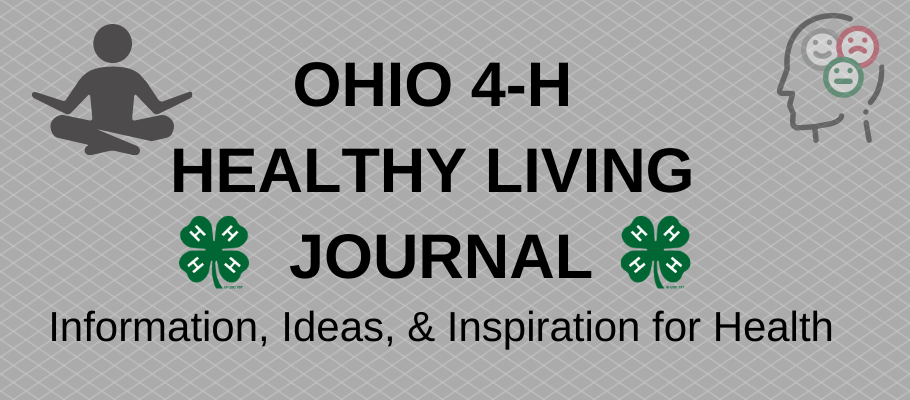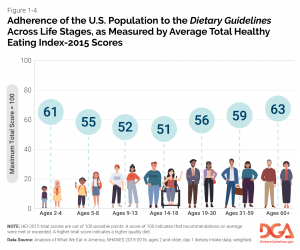 When thinking about health, physical health is likely one of the first aspects to come to mind, and the connection of food to physical health is not far behind. The foods we eat and the beverages we drink have a big impact on our health. However, we know that over time the eating patterns in the U.S. have remained below recommendations, while the science linking food and health has only become stronger. In the Dietary Guidelines for Americans, 2020-2025 you will find advice on what to eat and drink to meet nutrient needs, promote health, and help prevent chronic disease.
When thinking about health, physical health is likely one of the first aspects to come to mind, and the connection of food to physical health is not far behind. The foods we eat and the beverages we drink have a big impact on our health. However, we know that over time the eating patterns in the U.S. have remained below recommendations, while the science linking food and health has only become stronger. In the Dietary Guidelines for Americans, 2020-2025 you will find advice on what to eat and drink to meet nutrient needs, promote health, and help prevent chronic disease.
The U.S. Departments of Agriculture (USDA) and Health and Human Services (HHS) update the Dietary Guidelines for Americans at least every 5 years, based on current science. The guidelines translate science into recommendations to help people make healthy choices. The new edition for 2020-2025 is the first set of guidelines that provide guidance for healthy dietary patterns by life stage, from birth through older adulthood. It’s never too early or too late to eat healthy!
As this graph shows, teens are the least likely age group to have a healthy diet.
Healthy eating is not about following a particular diet for a short amount of time, but rather it’s about making healthy choices throughout life. A healthy dietary pattern is not a rigid prescription, it’s about a pattern of eating over time. The Dietary Guidelines provides a framework with a set of principles. These principles allow for flexibility to take into account personal preferences and cultural traditions.
How do we make every bite count? Making choices rich in nutrients should be the first choice. Nutrients are the building blocks of food, such as protein, vitamins, and minerals. When foods have a lot of nutrients, we say they are nutrient dense.
Small changes to individual parts of a meal can make a big difference. Let’s take a meal that is a favorite for many – a burrito bowl. The table below shows a comparison of two burrito bowls. Looking at the photos, they may seem pretty similar. But on closer examination, the comparison illustrates how the more nutrient-dense choices significantly improve the nutritional profile of the meal. The result of these changes is reflected in the calories count, as well as in lower amounts of fat, sugar, and sodium.
| Typical Burrito Bowl Total Calories = 1,120 | Nutrient-Dense Burrito Bowl Total Calories = 715 |
| White rice (1½ cups) | Brown rice (1 cup) + Romaine lettuce (½ cup) |
| Black beans (⅓ cup) | Black beans, reduced sodium (⅓ cup) |
| Chicken cooked w/ sauce (2 ounces) | Grilled chicken w/ spice rub (2 ounces) |
| No grilled vegetables | Added grilled vegetables (⅓ cup) |
| Guacamole (½ cup) | Sliced avocado (5 slices) |
| Jarred salsa (¼ cup) | Fresh salsa/pico de gallo (¼ cup) |
| Sour cream (¼ cup) | No sour cream |
| Cheese (⅓ cup) | Reduced-fat cheese (⅓ cup) |
| Jalapeño (5 slices) | Jalapeño (5 slices) |
| Iced tea with sugar (16 ounces) | Iced tea, no sugar (16 ounces) |
I hope this comparison has given you a sense of how small changes in the choices you make can produce big results and improve the nutrient density of a meal. Were you surprised by the difference in the number of calories? The nutrient density and healthfulness of what people eat and drink often is determined ultimately by how a food item, dish, or meal is prepared, whether at home and away from home, and the extent to which it features fresh versus processed foods. Look back at our posts on Tips for Taco Tuesday and Pizza with Pizazz for some ideas for foods you can prepare at home.
Today’s Take-Away: When it comes to nutrient density, remember that small changes can produce big results. The Academy of Nutrition and Dietetics offers some additional tips for choosing a nutrient-rich diet.
The topic of making healthy food choices is too big for one blog post – this is just a small bite. We’ll return to this topic in the future, so come back for more information and ideas.
Yours in Health,
Theresa Ferrari, Extension Specialist, 4-H Youth Development
Adapted from: Dietary Guidelines for Americans, 2020-2025




